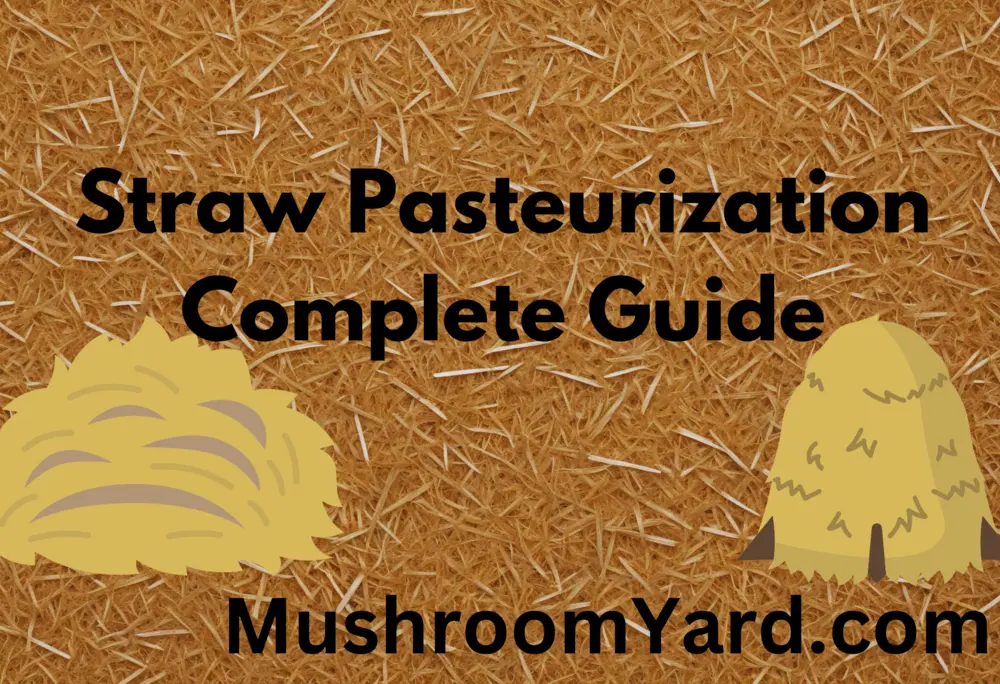

Straw pasteurization is a method used in mushroom cultivation to clean straw of harmful microbes without sterilizing it completely. This process leaves behind beneficial microorganisms and reduces the presence of molds and other contaminants that can interfere with mushroom growth. Let’s take a look at the basics and how Straw Pasteurization fits into the overall process of mushroom growing. Trust me, once you nail this process, your mushrooms will thrive like never before!
Mushrooms, like many of us, are picky eaters. They need a clean, healthy environment to grow their best. Pasteurizing straw helps eliminate harmful bacteria, mold, and unwanted fungi while keeping the beneficial microorganisms that help your mushroom mycelium flourish. In essence, pasteurization is the “deep cleaning” your straw needs to become a top-tier substrate.
Pro Tip: “Not all heat kills! Remember, pasteurization is about balance. Too much heat can sterilize the straw completely, but you need some microbes to support healthy mushroom growth.”
This whole pasteurization method involves essential 4 steps and I will explain each of those one by one. It’s an art form — a blend of science, patience, and a touch of mushroom magic. So you need to keep patience and complete all the steps carefully.
The journey starts here, and trust me, prepping your straw properly is half the battle. Begin by chopping your straw into smaller, more manageable pieces, roughly 3–4 inches long. This helps the heat and water to penetrate evenly.
Why it matters: Shorter straw equals better nutrient absorption for your mushrooms and fewer gaps for contaminants to hide.
Pro Tip: “Use a leaf mulcher or garden shears for quick chopping. Time is money, and this step can save you plenty!”
After chopping, the next critical step is soaking the straw. Some cultivators prefer soaking in regular water, but adding hydrated lime or even a dash of dish soap can elevate your results. The lime increases the pH level of the water, creating a hostile environment for contaminants.
How to Soak:
Quote to Remember: “It’s not about killing everything — just tipping the balance in your mushrooms’ favor.”
Now comes the core of the process: pasteurization. Here, you’re looking to heat the straw between 160°F and 170°F (70°C to 77°C) for about 1–2 hours. Keep the heat stable — too low, and harmful microbes will survive; too high, and you risk sterilizing the straw entirely (which is not ideal!).
Step-by-Step:
Pro Tip: “Use a candy thermometer or cooking thermometer for precise heat control. Fluctuations can ruin the process, so don’t guesstimate!”
Once the straw has been pasteurized, you’ll need to drain it thoroughly. Excess water can cause mold growth, and you don’t want that! Let the straw cool to room temperature before moving to the inoculation stage.
Key Tips:
Pro Tip: “Patience is key. If you inoculate too early (while the straw is still too hot), you risk killing the mushroom spawn. Wait until it feels comfortably cool to the touch.”
While the traditional heating method is time-tested, there are other ways to achieve pasteurization if you’re short on time or equipment.
Want a low-energy, low-heat option? Cold water pasteurization might be the solution for you. All you need is hydrated lime and water. Soak your straw in limewater for 12-24 hours, and you’re good to go!
Note: This method is a favorite for those looking to cut down on energy costs or avoid handling hot water.
If you’re open to using chemicals, hydrogen peroxide pasteurization can be another option. While it’s not as common, it’s a fast, effective way to clean your straw without heat.
Note: This method can be tricky, and it’s usually best for more experienced growers. Always handle chemicals with care!
Pasteurizing straw may seem like a chore at first, but it’s essential for growing healthy, abundant mushrooms. It’s a delicate balance between killing harmful microbes and maintaining the beneficial ones, but with the steps above, you’ll be well on your way to mushroom success.
Quote to Remember: “Master the art of pasteurization, and you master the mushroom game.”
In the end, mushrooms are as much about the process as they are about the results. By perfecting straw pasteurization, you’re setting yourself up for a fruitful and satisfying cultivation experience. Happy growing!
FAQ Section:
Q: Why not just sterilize the straw completely?
A: Sterilization eliminates all microorganisms, both good and bad. You actually need some beneficial microbes to help your mushrooms thrive and outcompete contaminants.
Q: Can I reuse pasteurized straw for future crops?
A: It’s not recommended, as the nutrients deplete over time and contaminants can build up. Always start fresh for the best results.
Would you like more tips on mushroom cultivation? Let me know in the comments!